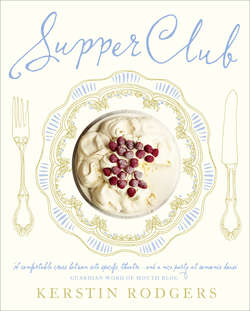Читать книгу Supper Club: Recipes and notes from the underground restaurant - Kerstin Rodgers - Страница 8
ОглавлениеLondon is a newcomer to the supper-club scene, although in the 1930s an experimental dining club ‘The Half Hundred’, held in the modernist Isokon building in Hampstead, was attended by the artists and intellectuals of the day, such as Agatha Christie and Henry Moore.
In fact, the very idea of food being important to British culture is quite a recent phenomenon. Britain leads the world in protesting against GM foods and declining fish stocks, while also promoting vegetarianism, animal rights and the growing of your own vegetables. At the same time, Britain, especially London, is a powerhouse of youth and alternative culture. Underground restaurants were just waiting to happen…
Home restaurants have been popular in Latin America since the Cuban revolution, where paladares (Spanish for ‘roof of the mouth’ or ‘palate’) were set up in response to government restrictions and the American embargo.
The pioneers of this phenomenon in London were Horton Jupiter, musician and host of supper club The Secret Ingredient, and me, under my blogging pseudonym of MsMarmiteLover. We both sprang from an alternative sub-culture in London where people lived cheaply, ate at donation-only squat cafés and ‘skipped’ food from supermarket bins (‘dumpster diving’), partly in response to sheer poverty, but also as a protest against consumer waste.
In January 2009, Horton opened his living room to strangers. Two weeks later I did the same thing. Now a new home restaurant or pop-up is starting every week in London, and is gradually rippling out to the rest of Britain. I get daily e-mails from all over the country, asking me advice on how to set up a home restaurant. In this book I set out a ‘how to’, a manual.
When I started The Underground Restaurant in January 2009, I announced it on my blog and was shocked when a hidden readership emerged out of the digital woodwork and left comments, asking if they could attend the first dinner. Things continued from there. It was difficult to handle the onslaught of interest from the world’s media at the same time as working out how to run a restaurant in my living room.
I called my living-room diner ‘The Underground Restaurant’, which has become a generic name for this type of restaurant. It’s not really a restaurant, more a table d’hôte with a fixed menu. It’s not literally ‘underground’ either (I have been asked this!), but conceptually, in the 60s counter-culture sense. The legality of supper clubs is not yet clear and the risks will be explored later in this book.
